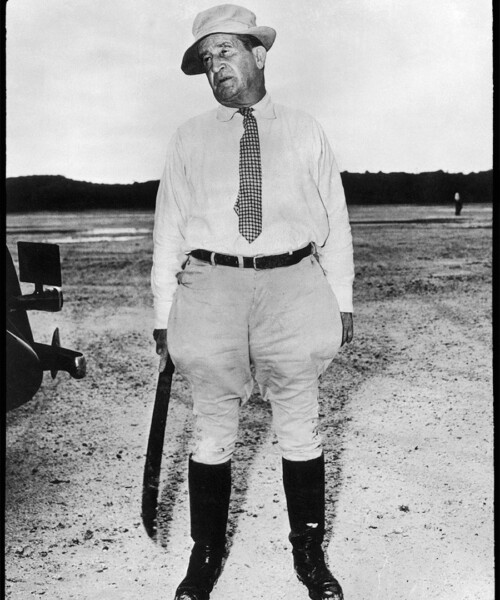It was July 8, 1943, an hour after dawn; a time and a season for everything to be quiet and slow-moving on the island of New Providence in the Bahamas. But not this morning. Frantic phone calls destroyed the drowsy, sultry calm. The largest landowner in the Bahamas, a man worth $200 million, had been found dead, and the cause was anything but natural.
Sir Harry Oakes, 68, born and raised in Maine, possessor of a Canadian gold-mine fortune and a British title, had been bludgeoned to death in the bedroom of Westbourne, his bougainvillea-adorned Nassau estate. From the looks of the crime scene, he’d also been set on fire. The walls bore bloodstains. Feathers were everywhere, their source a torn pillow, although some of the wilder rumors claimed they came from a chicken, evidence of a voodoo ritual.

The British Colonial Hotel in Nassau, Bahamas (Frederic Lewis/Getty Images)
To deal with the shocking murder and control the soon-to-balloon scandal, an aide woke up the governor of the Bahamas. The governor just happened to be a British royal, and an infamous one at that: the Duke of Windsor, formerly King Edward VIII, who in 1936 gave up his throne “for the woman I love,” American divorcee Wallis Simpson. The couple put on a good face for the public during their five-year-long stint in the Bahamas, but privately vented about their exile to “this hot little hell.”
The Duke of Windsor’s handling of the case—or, as most would describe it, mishandling of the case—went a long way toward firmly placing the killing of Oakes in a hall of fame of tantalizing mysterious murders. Oakes’s son-in-law, Alfred de Marigny, was swiftly arrested and tried for murder, but after a headline-saturated trial was found not guilty. No one else was ever charged, but theories on means and motives rage up to the present day. A cottage industry of books, novels and movies have tackled the case, dubbed “the unsolved murder of the century” in one review.

Alfred de Marigny and his wife Nancy in Nassau in November 1943, following his acquittal (Popperfoto/Getty Images)
One of the reasons the 1943 crime still exerts such a powerful fascination is that this pot brims with everything. “Toss away every notion, every preconception, you may have about the Bahamas in the 1940s,” declares Bahamianology, a website devoted to Bahamian history. “Put every idea as far away in your mind as humanly possible. The Bahamas was, in stark reality, a seething cauldron of Nazi sympathizers, British spies, money launderers, narcotics traffickers, gambling mobsters, land swindlers, murderers and paid-for-hire assassins.”
The book Murdered Midas, published in late 2019 by the Oxford-educated Canadian historian Charlotte Gray, has brought a new round of attention to the unsolved murder. In her excellent book, Gray not only crafts a carefully constructed “whodunit,” she takes a deep dive into Sir Harry Oakes himself, the first book to put Oakes in context as a major force in early 20th-century North American finance.

Murder suspect Alfred de Marigny (Oakes’s son-in-law) entering the Nassau Courthouse 1943 (Ralph Morse/The LIFE Picture Collection)
One of her motives was to establish Oakes as a person with many dimensions. In the decades since his murder, the millionaire’s image has become more and more loathsome. In books on the case he comes across as greedy, harsh, brutish and driven by grudges, almost suggesting he deserved his end. “He wasn’t likable,” Gray says in an interview with DuJour. “I wanted to find out why he had such a reputation.”
As a young man from a middle-class family, Oakes attended medical school for two years, but left in 1898 to follow his obsession: finding gold. He spent nearly 15 years working grueling hours in territories all over the world—abstaining from alcohol, near-friendless—in pursuit of his gold rush dream before he got his break at Kirkland Lake in northern Ontario. Gray compares his single-mindedness to today’s Silicon Valley tech entrepreneurs.
Once he’d made his fortune, Oakes chose not to expand his financial reach beyond his mines or establish himself as a cultural heavyweight like John D. Rockefeller, Andrew Carnegie or the Guggenheims. He bought property and became a local benefactor in Niagara Falls and Palm Beach, Florida. But his obsession became finding a way to seal off his money from taxation. This was what propelled Oakes to the Bahamas, a country with no income tax, in 1935. He was one of the first major tax exiles—not just in the Bahamas, but anywhere, Gray says.
Real estate developer Harold Christie, a man of legendary sales talent, courted Oakes until he persuaded the richest man in the British empire to establish residency in the Bahamas, then a crown colony. A 700-island tropical archipelago 50 miles off the Florida coast, the Bahamas at the time had 70,000 residents, three-quarters of them of African descent. The economic boom fueled by running rum and other booze into the U.S. during Prohibition was over. A small white elite in Nassau—nicknamed the “Bay Street Boys”—ran everything, shrugging off the poverty of most islanders.
Oakes bought a lot of property and built a golf course and an airport. He took his family with him to New Providence, a wife and five children. His favorite child seems to have been Nancy, a lively redhead. To her parents’ dismay, at the age of 18, Nancy married Alfred de Marigny, 32 years old and twice-divorced. According to Murdered Midas, he bore a Don Juan reputation in the Bahamas; he named his yacht Concubine and, according to persistent rumors, would drug young women before assaulting them.
De Marigny wasn’t the only unsavory person living tax-free in the Bahamas in the 1930s. Swedish industrialist Axel Wenner-Gren, owner of a 700-acre island that today is known as Paradise Island, was a well-known Nazi sympathizer. Wenner-Green made deals with the Krupps and counted Hitler’s No. 2, morphine addict and Luftwaffe overseer Hermann Göring, as a close friend.
Interestingly, in her book, Gray reveals little-known ties between Oakes and Nazi sympathizers forged before he moved to the Bahamas. The Oakes family had lived in Britain just long enough for the millionaire to receive his title. “The sinister friendships with pro-Nazi appeasers that he made in London during the 1930s, which probably secured his baronetcy…may have been a factor in his death,” Gray writes.
The afternoon that the Duke and Duchess of Windsor arrived in Nassau in 1940, when Britain was fighting Germany for its very existence, the question of Nazi sympathies became pressing indeed.
The days are long gone when the relationship of Edward VIII and Wallis Simpson was considered the love story of the century. In the popular Netflix series The Crown, the cover-up of the Duke of Windsor’s possibly treasonous sympathies with Germany takes up an entire episode.

Friends Harold Christie and Oakes visit El Salvador in 1941 (Bettmann/Getty Images)
Bestselling biographer Andrew Morton, in his book 17 Carnations, writes that before she married her royal lover, some people went so far as to regard Simpson as a promiscuous Nazi spy. The title of Morton’s 2015 book refers to a belief that Joachim von Ribbentrop, Hitler’s most valued diplomat, regularly sent Simpson bouquets of 17 carnations to celebrate how many times they’d had sex. Such stories were among the reasons that when Edward VIII insisted on marrying Simpson, the British government threatened to revolt and he was forced to abdicate, taking the new title of the Duke of Windsor.
After the Windsors made a string of disastrous decisions in France, Spain and Portugal, Prime Minister Winston Churchill ordered them to fill the vacant governorship in the far-off Bahamas, considered a backwater, for the duration of the war. Few could blame him. The Duke liked to tell people that if he’d remained king, England and Germany wouldn’t have gone to war. While they were in the Bahamas, the couple were watched carefully by the FBI and others. Among their suspicions was that in the special dry-cleaning Simpson sent to New York City were secret messages for German operatives.
Shortly after the Windsors arrived, they insisted on redecorating Government House in Nassau, pressuring the strapped Bahamian government to foot some of the bill. “The Duke and his wife were more interested in their home comforts and getting off the island in the first years,” says Morton, who also authored Diana: Her True Story in Her Own Words and Meghan: A Hollywood Princess. “They were concerned to have the official residence renovated at whatever cost.”
This changed after the United States entered World War II in December 1941. Morton says the Bahamas became an important training post, “and the Duke worked hard to ensure new arrivals were suitably accommodated… I think the Duchess comes away with high marks for the way she threw herself into war work.”
Unfortunately for the Windsors, in the view of most historians, any positive effort they put into their work was overshadowed by the Duke of Windsor’s actions after learning that his friend and favorite golf companion, Sir Harry Oakes, had been murdered. The Duke ordered that investigation duties be taken away from Bahamian law enforcement and given instead to two Miami police officers: Capt. Edward Melchen, who had served as the Duke’s bodyguard during a Miami visit, and Capt. James Otto Barker, a former ambulance driver.
The murder inquiry revealed that on the night of his murder, Oakes had a few people to dinner, including Harold Christie. (Oakes’s wife was escaping the heat in Maine.) The other guests left, but with a rainstorm lashing the island, Christie accepted Oakes’s invitation to spend the night in a bedroom down the hall from his own. The next morning, it was Christie who found the dead body of his host.
Oakes was known to dislike his wastrel son-in-law, and the two hadn’t spoken for several months. De Marigny lived nearby and, with his wife also off the island, had no one to vouch for his presence after his own evening guests went home.
It was not irrelevant that, on this small island, the French de Marigny and the Duke of Windsor despised each other. When the Miami police officers arrested de Marigny, letting it be known to Oakes’s family members that they had fingerprint evidence
condemning him, he was thrown in Nassau’s jail. The motive was described as his hatred of his father-in-law and desire to speed up his wife’s inheritance.
However, at the trial, the fingerprint evidence fell apart. It’s accepted by everyone familiar with the case that the Floridians falsified the damning fingerprint and bungled the evidence-gathering process overall. The jury found de Marigny not guilty.
In a twist, the court decided to nonetheless order the French-man’s deportation. With his loyal young wife at his side, de Marigny left the Bahamas, to stay for a while with his friend Ernest Hemingway in Cuba.
No other suspect was questioned; the official investigation was over, even though the man arrested had been found not guilty. It was as if people in charge didn’t want to press for answers.
So, who killed Sir Harry Oakes?
The theories that have emerged since 1943 have ranged from a killer reappearing from Oakes’s Canadian past to a rage-filled secret lover to a hit man sent by mobster Meyer Lansky.
Charlotte Gray is among those who find it significant that in the months before his murder, Oakes had become discontent on the island and had been thinking of moving to Mexico. For years, Oakes had lived under Harold Christie’s spell. But Oakes was growing worried that his riches weren’t truly safe from the taxman in the British Bahamas. Should the richest man on the island have left, it would have been ruinous for Christie and the Bay Street Boys.
Another ominous development: the multimillionaire pro-Nazi Swede Axel Wenner-Gren, who had been forced to leave the Bahamas and flee to Mexico, was in 1943 floating a scheme for Oakes and Christie to transfer money to Mexico City, sheltering investments in that neutral country. It’s been alleged that the Duke of Windsor had been approached to send his money to Mexico, as well. If questions about Oakes’s murder had followed a money trail to Mexico, it would have been a disaster for the Duke of Windsor.

Pictorial Parade/Hulton Archive
How could Christie have slept in a bedroom less than 20 feet away and not heard a thing while Oakes was bludgeoned to death and a fire was set? He told police he had stayed at Westbourne until morning, yet at de Marigny’s trial, a Bahamian police official testified he saw Christie riding in a car in Nassau the night of the murder. “Hired assassin” is the phrase people return to.
Christie’s dazzling ascent continued. He was knighted in 1964 and died in 1973, by which time the Bahamas was a highly desirable vacation destination and spot for luxury homes. The New York Times wrote in his obituary, “His company, H. G. Christie Real Estate, was one of the first to realize the potential of the Bahamas as a vacation land and played a major role in the development of Nassau and the outer islands.”
His great triumph was Lyford Cay on the western tip of New Providence Island. Christie built up the area and sold it to another businessman in 1954, and it became one of the most exclusive neighborhoods in the world, home to Greek shipping magnates, statesmen, moguls, royalty and actors like Sean Connery.
But while the Bahamas’s fame grew, Oakes’s unsolved murder remained in the background like a persistent sea breeze. British writer William Boyd, keen to write a novel about the case, wrangled an invite in 1985 to a private party on Lyford Cay to poke around. (His book Any Human Heart would eventually be made into a television miniseries featuring Gillian Anderson as the Duchess of Windsor.)
In a story he wrote for The Guardian, Boyd says that he was suddenly approached by a “burly” man: “Are you the person asking questions about Harry Oakes?”
Boyd was told that if he kept probing, he’d be thrown out of the party. In the end, it seems there are questions about the murder of Oakes that, even if allowed to be voiced, cannot be answered.







































